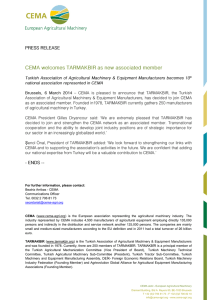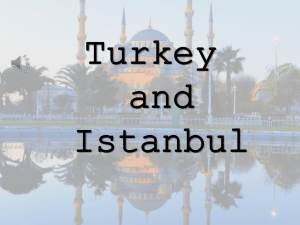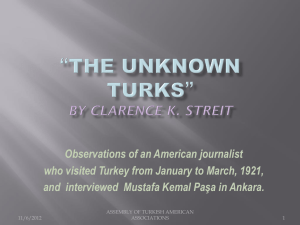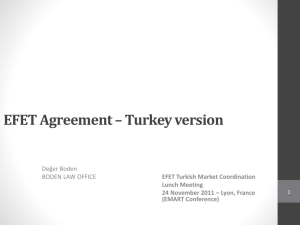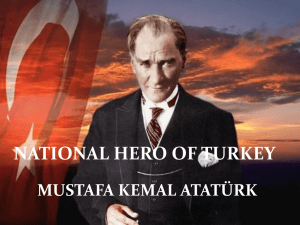karagoz-hacivat shadow plays and traditional turkish music
advertisement
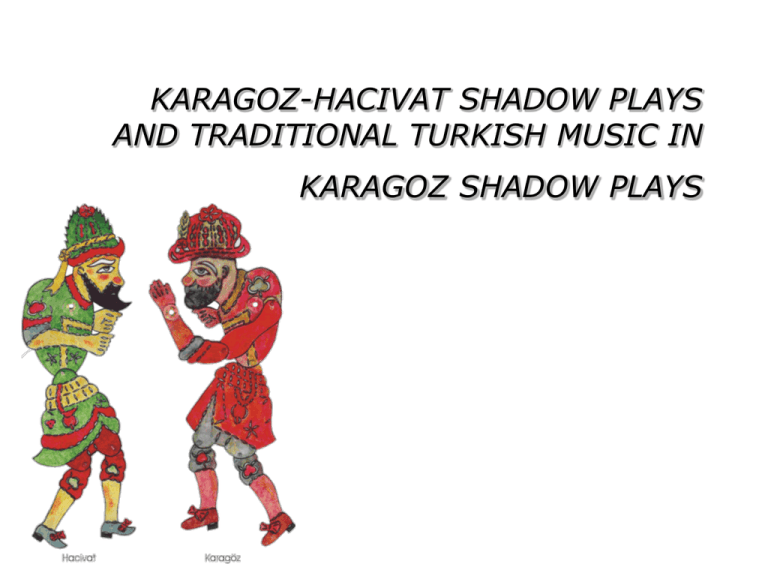
KARAGOZ-HACIVAT SHADOW PLAYS AND TRADITIONAL TURKISH MUSIC IN KARAGOZ SHADOW PLAYS The Popular Theater Tradition (Meddah and puppet shadow play Karagoz Hacivat) The Turkish theater improved in two different geographical areas: in old Istanbul and other cities, and in the villages popular theater was a pastime of the urban middle class. It was presented to the public by three classes of professional performers: live actors; story tellers and puppeteers ( both puppet shadow play and puppets Turkish mean is Kukla). Its characteristic points were imitation of dialectic invention , and imitation of animals by stock characters called taklit, easily recognized by the spectator because of their standard costumes, tunes and dances. The comedian, puppet shadow play master , puppeteer and storyteller memorized certain all phrases in rhymed couplets enacted scenes from everyday life, using the colorful saying of their time. Men played woman’s parts. Performances were given, not in special buildings. They could be performance in public squares, at national and religious festivals, at weddings , circumcision ceremony (Turkish mean is Sünnet) and fairs, in the yards of inns, in coffee houses, in taverns and private residences. Everything was done to music: wrestling matches were carried with music, conjurers (illiusionists) performed to the sound of the tambourine. The plays had little or no action, depending for laughs on monologues or dialogues involving puns, ready responses, crude practical jokes, double meanings, misunderstandings, and interpolated quips. There were clearly formulated rules of diction. Performances were often include with songs or dances, or both. Introduction of Shadow Play KARAGOZ In fact nothing is known of popular theater under the Anatolian Turks between the twelfth and fourteenth centuries. The Byzantine Emperor Manual Palaeologos II records his action of his visit to Sultan Beyazit’s court sometime before 1407 and mentions companies of musicians, singers, dancers and actors. A very early description of a Turkish dramatic performance may be found in the epic prose poem. The Alexiad of Anna Comnena, the eldest daughter of the Emperor Alexius Comnenus, who describes in the following words how the actors at the Seljuk court ridiculed her father who was suffering from gout: “Never before had the Emperor suffered so severely from that pain... and the Emperor’s suffering in his feet, and the trouble in his feet, become the subject of comedies. First they would impersonate the Emperor, then they would depict the Emperor himself lying on a couch, and make play of it. These puerile games aroused much laughter among the barbarians.” CHARACTERS OF KARAGOZ SHADOW PLAYS We can not separate the performance and the characters of the shadow theater from the social context and ethos of the Ottoman Empire in which it was generated and firmly located in its context. It was a large empire spread over three continents; Europe, Asia and Africa. Its population consisted of several nationalities, religions and ethnic groups, all of which saw Istanbul as their capital, a natural centre. Karagöz Karagöz is the leading man in this play. He is an unschooled crowd man. He can’t understand Hacivat’s alien words or makes wrong sense of their words’ real meaning. This situation makes up some funny dialogues and events. Karagöz is a uncultured man but sometimes he jokes about Hacivat’s parlance. Because Hacivat uses foreign words with Turkish grammatical and he thinks it is mockery. He is so chatty. Unless he is in the street, he looks at the window and chimes in the dialogues.Except Hacivat’s works usually he doesn’t have a work. He uses a hat with lights on it which called “Işkırlak”. He becomes different types with different clothes in different plays. (For example: Bride Karagöz, Donkey Karagöz, Naked Karagöz etc.) Hacivat Hacivat speaks out of both sides of your mouth so he is an artful person. He just thinks about his own needs. He is -a littleeducated so he likes speak with foreign words. He employs Karagöz and take his gains. Usually he exists by that way. He becomes different types with different clothes in different plays, too. Zenne All women’s name in Karagöz-Hacıvat Play are “Zenne”. Women in this play are young, middle-aged and old, flighty, combative, only just faithful and always prone to gossip. The main type is always flighty and given to intrigue. In nearly every play, this type causes a scandal in the neighbourhood. Çelebi He speaks a perfect Turkish with Istanbul accent. Sometimes he becomes a rich man, sometimes he becomes a prodigal son but whatever he becomes he is in pleasure. He is graceful, dainty and effeminate. He dresses in European style and always packs an umbrella, a bouquet or a stick. Bebe Ruhi Bebe Ruhi, the dwarf has a lisp in his speech and says r and s as y. He asks the same questions over and over again until people become tired of listening to him. Sometimes he is a dwarf and sometimes a hunchback. He often does weird jobs around the neighbourhood. Karagoz on many occasions, has to beat him in order to get rid of him. He spends all his time smoking opium and sleeping in the neighbourhood coffee house. He can easily be identified by his pipe, his fan and a huge humped shoulder. He is a flippant type but always tries to look serious. He speaks like Hacivat but has a bad blood of frequently going to sleep in the middle of a talk and snoring loudly. Laz Laz, who comes from the Black sea coast, is either a boatman, a wool beater or a tinsmith. He has a strong Black Sea coast accent. He is very talkative and also speaks quickly. As he usually so busy talking himself, he can not listen to what other people say. He has a habit of becoming angry in a very short time. He often dances on the stage a Black Sea dance called horon, which is characterized by alert, tense shivering movements, the trembling of the entire body from head to foot, sudden sharp kneeling and springing up at the rebound. This fits in which the basic traits of his character. Himmet Baba Himmet, for example, is the unbeatable wood cutter from Anatolia, a tell man (the tallest of the shadow figures, as we have already mentioned), carrying a large axe on his shoulder. He has a good heart and always thinks and talks about his sweetheart in his own village. Those from Kayseri and Bolu are similar to Turk but are better acquainted with Istanbul life. TRADITIONAL TURKISH MUSIC IN KARAGOZ SHADOW PLAYS Turkish Music plays an important part in traditional Turkish play called Karagöz. Turkish music as performed in these plays has acquired a characteristic of its own ands become a musical genre peculiar to old Istanbul’s urban light Turkish music. It is unthinkable to consider a Karagoz play in which Turkish music is not given performance. Music is these plays brings together several different genres and composition forms of Ottoman - Turkish music. Apart from the composition forms of classical Turkish music like the kâr, kârçe, murabba, beste, semai, sarki and vocal and insturmantel improvisations known as the gazel and taksim, other genres like the köçekçes, tavsancas and dance music pieces of urban light Turkish music, Thracian (Rumeli) Anatolian folk songs, songs whose texts are based on Arabic and Judeo-Spanish, the language of the Ottoman Jews, Gipsy songs, Greek and Armenian songs, waltz, polka and opera arias were also given performance in the in the Ottoman shadow plays. The variety of subjects of the plays caused the musical repertoire to expend in the course of time. The notated repertoire of Turkish music consits of compositions of the nineteenth and twentieth centuries. Musical instruments used in shadow plays may be divided into two groups: the ones which appear on the curtain and those used behind the curtain. The spectators see the rular folk music instruments on the curtain while they hear the performance of those used in classical and urban music. In old Istanbul, from the Sultan to the simple man in the street, from the learned to the illiterate took pleasure from this shadow play. Karagoz was a product of true urban culture. This aspect of Karagoz has clearly been reflected in its music whose repertoire extends from classical songs to light melodies and dance pieces. This amazing repertoire is a significant expression of old Istanbul’s urban music. Thanks for your patience… Aybüke Karaoğlu Tanya Varer
